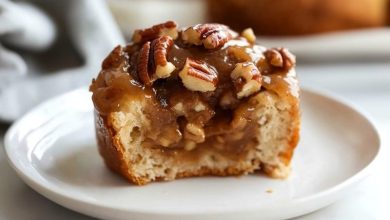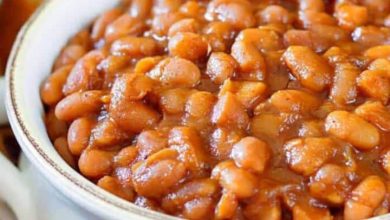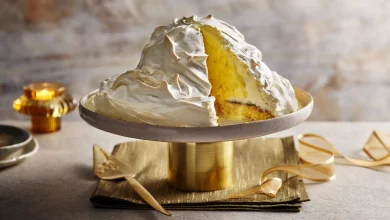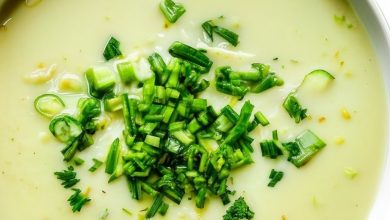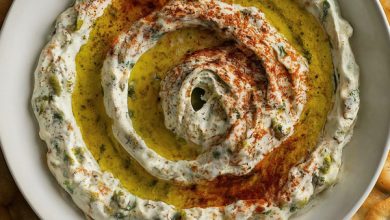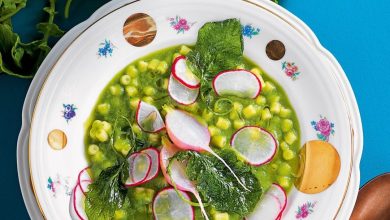Strawberry Rhubarb Jam with Jell-O – Quick & Easy Recipe
Introduction
At Love With Recipes, we understand that creating homemade jams not only allows you to enjoy fresh, natural flavors but also provides a delightful way to preserve seasonal fruits for year-round enjoyment. Rhubarb, with its distinctive tartness, lends itself beautifully to sweet preserves that balance acidity with sweetness, making it an excellent candidate for quick, straightforward jam recipes. This Easy Rhubarb Jam is a testament to simplicity and flavor harmony. Originally discovered in an old church cookbook, this recipe captures the essence of traditional fruit preserves and modern convenience, ensuring that even novice cooks can achieve professional-quality results. Its vibrant hue and balanced flavor profile make it a versatile addition to your pantry, perfect for spreading on breakfast breads, dolloping over desserts, or gifting to loved ones during the holiday season.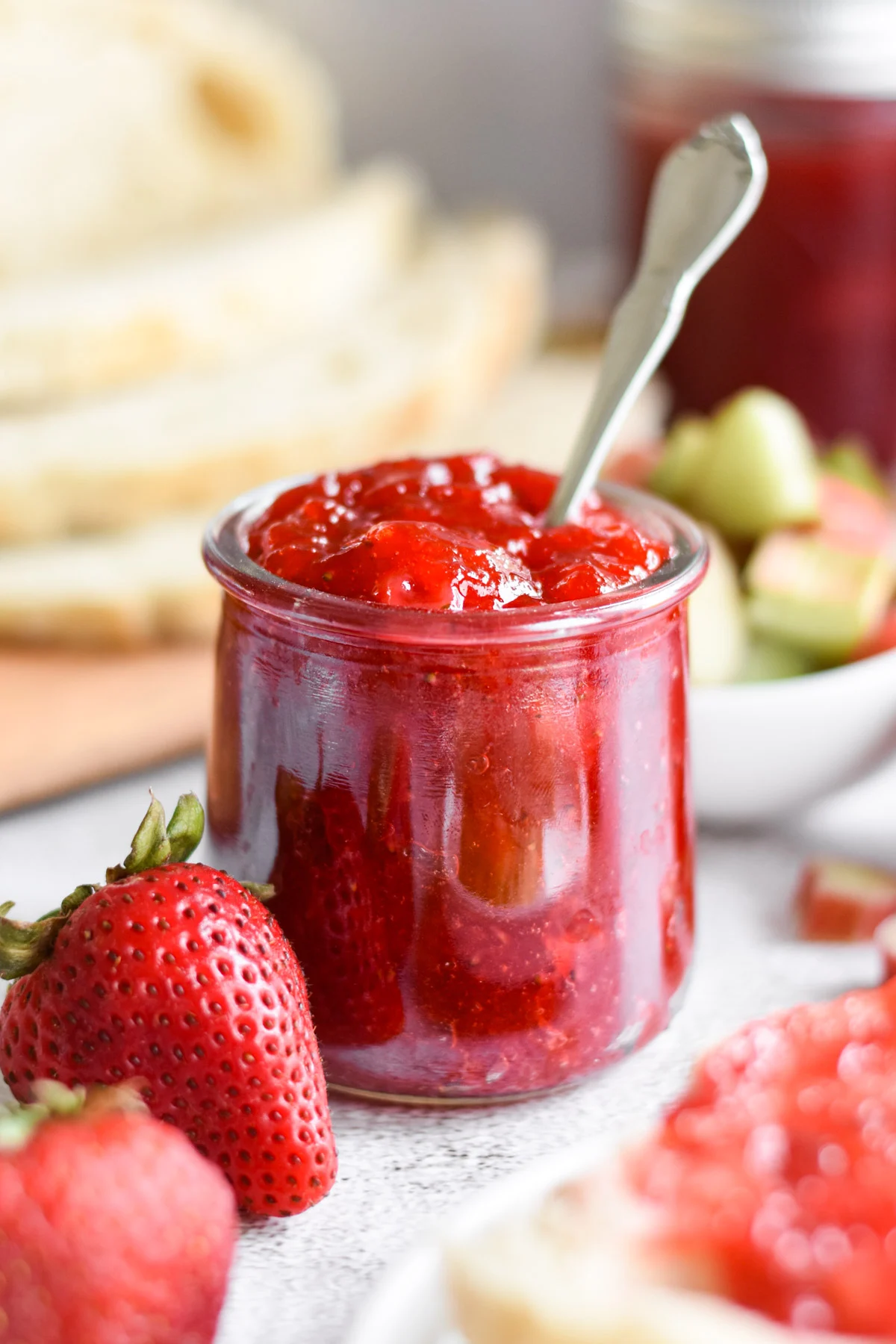
Designed for those who crave a homemade touch without hours of cooking or complicated techniques, this jam combines fresh rhubarb with strawberry Jell-O to create a smooth, flavorful spread in under 30 minutes. The inclusion of strawberry Jell-O adds a layer of sweetness and stabilizes the gel-like consistency, resulting in a luscious, spoonable jam that holds its shape beautifully. Whether you’re a seasoned canner or just starting your journey into homemade preserves, this recipe offers a delectable, fuss-free way to enjoy the bounty of rhubarb season.
Time
Preparation Time
15 minutes
Cook Time
15 minutes
Total Time
30 minutes
From initial preparation to the finished product, this recipe is optimized for efficiency, making it ideal for busy households or last-minute craving moments. The minimal cooking time does not compromise on flavor or texture, resulting in a fresh, lively jam that captures the essence of spring and summer harvests.
Needed Equipment
Essential Tools for Perfect Rhubarb Jam
- Large heavy-bottomed saucepan: Ensures even heat distribution and prevents scorching during boiling.
- Wooden or silicone spatula: For stirring the mixture gently, avoiding scratches on the pan.
- Measuring cups and spoons: Precise measurement of ingredients is crucial for consistent results.
- Sharp knife and cutting board: To chop the rhubarb into uniform pieces for even cooking.
- Heat-resistant bowl or container: For cooling the jam before storage.
- Sieve or fine-mesh strainer (optional): To remove any remaining fibrous bits or seed particles, ensuring a smooth texture.
- Sterilized jars or containers: For storing the finished jam, preferably glass with tight-fitting lids.
- Freezer-safe storage containers: For long-term preservation without risk of freezer burn.
- Thermometer (optional): To monitor the temperature, especially if you want to ensure precise boiling points.
- Cooking thermometer (optional): Helpful for checking jam consistency, although not strictly necessary for this recipe.
Additional Equipment for Advanced Preparation
- Jam funnel: Facilitates transferring jam into jars without spills.
- Label maker or waterproof marker: For labeling jars with date and contents for easy identification.
- Cooling rack: To place freshly filled jars on for even cooling and to prevent condensation buildup.
Tags
Fruit Jam, Rhubarb, Strawberry, Easy Recipes, Quick Preserves, Homemade Jam, Vegan, Vegetarian, Gluten-Free, No Artificial Preservatives, Seasonal Fruit, Family-Friendly, Beginner Cooking, No Canning Required, Freezer Jam, Healthy Snack, Breakfast Spread
Serving Size
Approximately 1 tablespoon (15 grams) per serving
Yield: About 2 to 2.5 cups of jam, depending on the exact amount of rhubarb and water used.
Difficulty Level
Easy
This recipe requires minimal culinary skills and simple techniques, making it suitable for beginners and experienced cooks alike. The straightforward steps and quick cooking process ensure success even for those new to jam-making.
Allergen Information
This recipe is free from common allergens such as nuts, dairy, and gluten. However, it contains gelatin from the strawberry Jell-O, which may be a concern for vegetarians or those avoiding gelatin. For a vegetarian or vegan alternative, consider using agar-agar powder or other plant-based gelling agents.
Dietary Preference
Vegetarian, Vegan (if using plant-based gelatin substitute)
Gluten-Free
Low Cholesterol
Low Protein (due to fruit content)
Course
Spread, Preserves, Snack
Cuisine
American, Seasonal Fruit Preservation
Ingredients
| Ingredient | Quantity |
|---|---|
| Fresh rhubarb (cut into small pieces) | 3 cups |
| Granulated sugar | 2 ½ cups |
| Water | ½ cup |
| Strawberry Jell-O gelatin dessert | 1 box (3 oz) |
Optional substitutions include using organic or less refined sugar for a healthier option or adding a splash of lemon juice for extra brightness.
Instructions
Step 1: Preparing the Rhubarb
Begin by selecting fresh, firm rhubarb stalks. Rinse thoroughly under cold water to remove any dirt or residual pesticides. Using a sharp knife and a sturdy cutting board, trim off any leaves (which are toxic and should never be consumed) and cut the stalks into small, uniform pieces—about ½-inch chunks. Uniformity in size ensures even cooking and a consistent texture in the finished jam. Place the chopped rhubarb into a large mixing bowl or directly into your cooking saucepan, depending on your workflow.
Step 2: Combining Rhubarb and Water
Transfer the chopped rhubarb into a large, heavy-bottomed saucepan. Add the measured ½ cup of water. This small amount of liquid helps initiate the cooking process and prevents the fruit from sticking or burning during initial heating. Place the saucepan over medium heat. As the heat increases, the water will begin to simmer and help soften the rhubarb. Stir occasionally with a wooden or silicone spatula to prevent sticking and to promote even heat distribution.
Step 3: Cooking the Rhubarb
Allow the mixture to reach a gentle boil, which indicates that the water is actively steaming and the fruit is starting to soften. Maintain medium heat, stirring gently as needed to prevent the rhubarb from sticking to the bottom of the pan. Continue cooking until the rhubarb has broken down significantly, releasing its juices and creating a thick, jam-like consistency. This process typically takes about 8-10 minutes. The rhubarb should be tender but not completely liquefied; some small chunks should remain for texture.
Step 4: Incorporating Sugar
Once the rhubarb is adequately softened, carefully add the 2 ½ cups of granulated sugar. Stir thoroughly to dissolve the sugar completely into the hot mixture. The sugar not only sweetens the jam but also promotes the gelling process. During this step, keep the heat at medium to prevent the mixture from scorching. Stir frequently to ensure that the sugar dissolves evenly and the mixture begins to thicken. The sugar will draw out more liquid from the rhubarb, resulting in a syrupy consistency.
Step 5: Bringing to a Rolling Boil
Increase the heat slightly to bring the mixture to a vigorous, rolling boil. This is a critical stage for setting the jam. The boiling should be vigorous and continuous, with large bubbles constantly breaking the surface. Stir often during this phase to prevent sticking or burning, especially at the edges. The boiling process helps to concentrate flavors and reduces the moisture content, ensuring a good gel point is achieved.
Step 6: Boiling for the Correct Duration
Allow the mixture to boil for exactly 2 minutes. Use a kitchen timer to ensure accuracy. During this time, maintain a steady boil and stir frequently. This step is essential for developing the ideal texture and ensuring the jam sets properly when cooled. The rapid boiling also helps to evaporate excess water, intensifying the flavor and creating a glossy, thick consistency.
Step 7: Adding Strawberry Jell-O
Remove the saucepan from the heat source. Immediately stir in the entire box of strawberry Jell-O gelatin dessert—about 3 ounces. Continue stirring until the gelatin is fully dissolved and uniformly incorporated into the hot rhubarb mixture. The gelatin acts as a natural thickener and stabilizer, giving the jam its characteristic gel-like consistency and bright flavor. Ensure there are no lumps or undissolved gelatin particles to achieve a smooth, consistent texture.
Step 8: Cooling and Final Texture Development
Allow the jam to cool slightly in the saucepan, stirring gently every few minutes. As it cools, the mixture will thicken further, and the flavors will meld. This cooling phase is crucial for attaining the perfect spreadable texture. Do not refrigerate immediately; instead, let it sit at room temperature for about 15-20 minutes until it reaches a manageable temperature. The jam should no longer be hot to the touch but still fluid enough to pour or spoon into storage containers.
Step 9: Transferring and Storing
Using a ladle or spoon, carefully transfer the cooled jam into sterilized jars or freezer-safe containers. Leave about ¼ inch of headspace at the top to allow for expansion during freezing or refrigeration. Seal tightly with lids. For immediate use, refrigerate the jam; for prolonged storage, freeze the containers. Label each container with the date and contents for easy identification. This jam keeps well in the freezer for several months and in the refrigerator for up to 2 weeks.
Preparation Tips
- Uniform Rhubarb Chopping: Use a sharp knife and consistent chopping size to ensure even cooking and a uniform texture.
- Timing of Sugar Addition: Add sugar after the rhubarb has softened to prevent crystallization and promote proper gelling.
- Monitoring Boil: Keep a close eye during the boiling phase to prevent over- or under-cooking, which affects texture.
- Gel Consistency: If you prefer a firmer jam, increase boiling time by 30 seconds to 1 minute, but be cautious not to overcook.
- Flavor Enhancements: For a citrus twist, add a tablespoon of lemon juice or zest during the sugar addition phase.
Nutritional Information
| Nutrient | Per Batch |
|---|---|
| Calories | 2,336 kcal |
| Fat | 0.7g |
| Saturated Fat | 0.2g |
| Cholesterol | 0mg |
| Sodium | 413mg |
| Carbohydrates | 593g |
| Dietary Fiber | 7g |
| Sugar | 577g |
| Protein | 10g |
Note: Nutritional values are approximate and based on standard ingredient measurements.
Tips and Tricks
- Use ripe rhubarb: Ripe rhubarb offers more flavor and natural sweetness, reducing the need for excessive sugar.
- Adjust sweetness: Taste the mixture before adding the gelatin; if too tart, add a little more sugar or honey.
- Test gel point: Place a small spoonful on a cold plate and refrigerate for a minute; if it wrinkles when pushed, it’s ready.
- Batch small: For quick cooling and storage, divide the jam into smaller containers rather than one large jar.
- Vegetarian option: Substitute strawberry Jell-O with agar-agar dissolved in hot water, following package instructions.
Add-ons
- Fresh mint leaves or basil for a herbal twist.
- Adding a splash of vanilla extract during the cooling phase.
- Incorporating chopped strawberries or other berries for variation.
- Mixing in chia seeds for added fiber and texture.
Side Dishes
- Serve atop warm scones, English muffins, or toast for breakfast or brunch.
- Use as a topping for vanilla or lemon-flavored ice cream and yogurt.
- Spread between layers of sponge cake or in thumbprint cookies.
- Pair with cheese platter selections like brie or cream cheese on crackers.
- Mix into oatmeal or porridge for added flavor and sweetness.
Improvements
- Reduce sugar: Use alternative sweeteners like agave syrup, honey, or stevia for a healthier version.
- Flavor infusions: Add spices such as cinnamon, ginger, or cardamom during cooking for a spiced variation.
- Texture adjustments: Blend part of the jam for a smoother consistency or leave chunks for a chunky spread.
- Preservation methods: For longer shelf life, consider water bath canning following safe guidelines.
Save and Store
For maximum freshness, store the jam in airtight containers. Refrigerate immediately if planning to consume within two weeks. For longer storage, freeze the jam in freezer-safe containers, leaving room for expansion. Label with the date of preparation to keep track of freshness. Properly stored, the jam maintains quality for up to 6 months in the freezer. To thaw, transfer to the refrigerator overnight. If you wish to preserve the jam for extended periods, water bath canning is recommended, following USDA guidelines.
FAQ
Can I use frozen rhubarb instead of fresh?
Yes, frozen rhubarb can be used. Thaw and drain excess moisture before chopping to prevent excess liquid in the jam. The flavor and texture remain comparable to fresh rhubarb.
Is strawberry Jell-O necessary?
While it adds flavor and helps set the jam, you can omit it or substitute with agar-agar for a vegetarian version. Keep in mind that the texture and flavor will change slightly.
Can I make this jam without added pectin?
Yes, the gelatin in Jell-O acts as a natural gelling agent, so additional pectin is unnecessary. Adjust boiling time if you prefer a firmer or softer set.
How long does homemade rhubarb jam last?
Refrigerated, it lasts up to 2 weeks. Frozen, it maintains quality for up to 6 months. Proper sterilization and sealing are essential for longevity.
Can I double the recipe?
Yes, double the ingredients, but ensure your saucepan is large enough to accommodate the increased volume and to prevent boiling over.
Conclusion
Crafting homemade rhubarb jam with minimal fuss is an excellent way to preserve the lively, tangy flavor of rhubarb while enjoying the sweet, comforting qualities of strawberry. This recipe’s simplicity makes it accessible to cooks of all skill levels, and its quick preparation time means you can indulge in fresh, delicious jam without hours of simmering or canning. Whether used as a breakfast spread, a dessert topping, or a thoughtful gift, this jam exemplifies the joy of homemade preserves. Remember to follow safety practices in sterilization and storage to ensure your jam remains fresh and flavorful for months. For more detailed recipes and seasonal inspiration, visit Love With Recipes—your trusted platform for delicious, tested recipes that bring joy to every table.
References
- Ball Blue Book of Preserving, 37th Edition, Ball Corporation, 2014.
- USDA Complete Guide to Home Canning, USDA, 2015.

